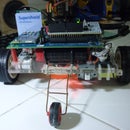Introduction: Yet Another Joule Thief Tutorial
This is a tutorial for making the ever-popular LED Joule Thief. I made this instructable as a companion instructable
for my Joule Thief 10x10 LED Lamp.
Description of a joule thief from Wikipedia:
A joule thief is a minimalist self-oscillating voltage booster
that is small, low-cost, and easy to build; typically used for driving light loads. It can use nearly all of the energy in a single-cell electric battery, even far below the voltage where other circuits consider the battery fully discharged (or "dead").
A more understandable description:
The joule thief is a circuit that makes it possible to light up your typical LED's with 'dead' batteries. It does that by using the last bits of the power in those batteries, boosting it up to the voltage enough to make LED's light up.
So prepare your used batteries, and come with me to the journey of building the Joule Thief!
Step 1: Preparing the Materials
One of the things you need to do before building something is preparing the materials. In this case most things we need can be salvaged easily. You can also buy them but building something from thrown away electronics is always more awesome.
The core part for the Joule Thief is the toroidal core. It is the thing that makes all this magic work!
The toroidal core can be found from the circuit board of a compact fluorescent lamp (CFL). It is normally found warped in some wires so remove them before using them here.
Warning: Be careful when taking the circuit boards from these lamps out. Don't break the tube of the lamp as it contains mercury vapour which is very poisonous.
After acquiring the toroidal core, you will need the magnet wire also known as the enamelled copper wire.
This wire can be found in transformers and is also used as inductors.
You will also need a 1kohm resistor and a NPN transistor. I used a 2N3904. 2N2222 and 2N4401 works too.
Now, after you have acquired everything you need to build a Joule Thief, let's go to the next step where you find out how to wind the wires to and to wire everything together.
Step 2: Winding the Magnet Wire.
Get about 60 cm of magnet wire and fold it in half. After that start winding the magnet wire starting from the connected ends. Try to keep the wires tidy so that it will look nicer in the end. Wind the wires around the toroidal core for about 8 to 11 turns. After winding the wires trim the ends leaving about 1cm or so for soldering later .(I left about 3 cm, it will be trimmed later during soldering) Sand the four ends of the wires to remove the enamel coating.
Now get your multimeter out (in continuity mode) and test the wires to find the ends of the 2 wires. If the wires are connected, then it is incorrect, you need to get the ends that are not connected. After confirming which one is not connected, twist them together so they are connected. Once they are connected you can proceed to test the circuit.
Step 3: Building and Testing Circuit
Based on the given schematic, wire the circuit on a breadboard or if you are confident you can solder them together.
The part where the wires are twisted together are supposed to be connected to the positive end of the battery and the other two ends are to be connected to a 1k resistor in series with the base of the NPN transistor (in my case it's the middle pin.) and the collector of the transistor.(right pin in my case.) The emitter of the transistor is then connected to the negative end of the battery. Lastly, the LED is to be connected to the collector and the emitter of the transistor. (anode - collector, cathode - emitter)
If the LED lights up, congratulations of finishing the circuit, but if it does not, check your wiring and windings and make sure they are correct. If you still can't get it to work, feel free to comment and I'll try me best to help you to make it work.
Step 4: Soldering
I build this Joule Thief for my LED nightlight so it is assembled inside s tight space in the battery holder I used. I modified the battery holder so all the batteries are connected in parallel and then I wire the circuit up, Most of the parts are heat-shrinked to prevent shorts so it might be a little hard to see where is some of the components.
Step 5: Complete
These are the LED nightlight I've made in another instructable. They are all powered by <1.5 volts. This makes them easy to be powered and you can use up most of your 'dead' batteries' power.
Do vote for me if you liked this tutorial.
Thanks for reading this and I hope you have learnt something....

Participated in the
Make it Glow!













